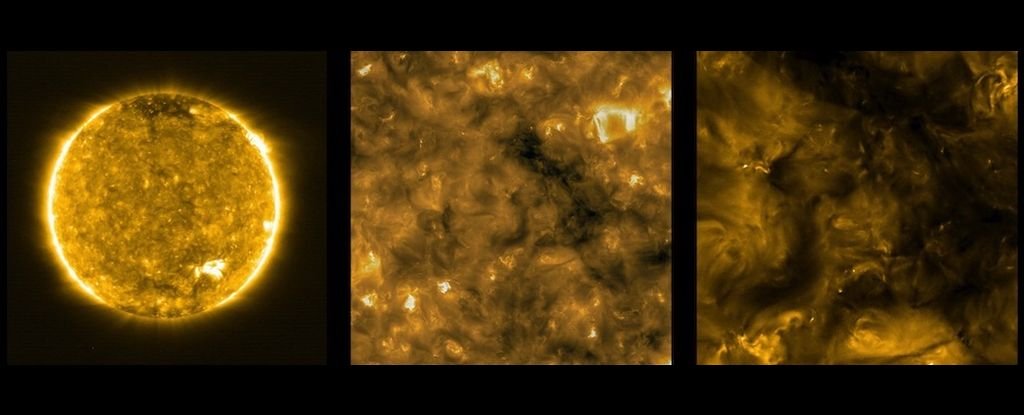Sunspots aren't the only speckles decorating the dynamic face of our Sun. Solar physicists have made a close study of tiny, fleeting speckles of brightness that emerge and fade in less than a minute on average, in regions where loops of plasma rise from the solar surface.
They're named 'solar dots'. The fleeting phenomenon, analysis has revealed, is likely the result of magnetic shenanigans – which wouldn't be hugely surprising, given that magnetic field changes play a huge role in all sorts of wacky solar phenomena.
Nevertheless, the finding suggests the Sun is even more complex than we knew; analysis of these sun freckles could improve our understanding of the role of the magnetic field on solar dynamics, and the magnetic field itself.
The fascinating dots were, ahem, spotted in images from the joint NASA-ESA Solar Orbiter, which launched in 2020 when the Sun had just entered a new cycle, and was growing more active.
On 20 May 2020, the spacecraft imaged some regions of magnetic flux, with magnetic loops arcing up from the solar photosphere.
The solar magnetic field is a complicated beast. It's generated by a dynamo process in the solar interior – the motion of a convecting, conducting fluid that generates electric and magnetic fields. We don't know exactly how it works, but the resulting magnetic field lines are numerous, dynamic, and complex.
Sunspots, for example, are regions where magnetic fields are particularly strong, and solar flares and coronal mass ejections are produced by magnetic field lines snapping and reconnecting.
The 11-year solar cycles mentioned earlier are driven by the magnetic field reversal that takes place every 11 years, when the solar magnetic poles switch places.
Led by astrophysicist Sanjiv Tiwari of the Lockheed Martin Solar and Astrophysics Laboratory, a team of scientists took a closer look at one of these magnetic flux regions, imaged in extreme ultraviolet wavelengths. They found tiny, round specks of brightness almost hidden in the solar plasma.
Image processing drew the dots into greater prominence, allowing the team to study them in detail. Over the course of about an hour, they were able to observe and characterize around 170 dots.
Overall, on average, the dots were around 675 kilometers (420 miles) in diameter (hey, that's small for the Sun), were around 30 percent brighter than the surrounding plasma, and lasted, on average, just 50 seconds before disappearing again. About half the dots remained isolated for the duration of their brief lives, while the remainder split into two, merged with other dots, or developed explosive loops or jets.
Comparison with data from NASA's Solar Dynamics Observatory showing the Sun's magnetic field revealed that the dots appeared in the entire field of view covered by Solar Orbiter, but were more densely clustered in more magnetically active regions, especially the bigger and brighter dots.
The next step was to try and figure out what causes the speckles. This required the use of software that simulates the magnetohydrodynamics of the solar atmosphere, Bifrost.
This simulation revealed that the dots may be moments of magnetic reconnection between magnetic field lines emerging from the solar surface, and magnetic field lines descending into it.
Since magnetic reconnection in the solar atmosphere produces loops, this would explain why many of the dots stretch into an extended loop during their evolution.
However, some of the dots did not appear in regions with tangled magnetic fields, which suggests there might be multiple formation pathways for these mysterious features. One possible explanation, the team said, is the propagation of magnetoacoustic waves in the solar plasma, which could produce shocks that result in dots.
But the mystery is far from resolved. The dots imaged by Solar Orbiter aren't the only dots seen on the Sun, and they have been observed in different wavelengths and different magnetic environments.
Future research, the team said, could help to resolve these open questions, bringing us closer to truly understanding our fascinating star.
The research has been published in The Astrophysical Journal.
- Mutton and Karlston
-

 2
2



Recommended Comments
There are no comments to display.
Join the conversation
You can post now and register later. If you have an account, sign in now to post with your account.
Note: Your post will require moderator approval before it will be visible.